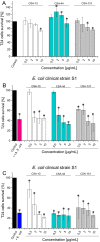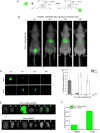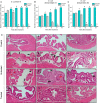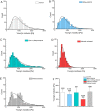Ceragenin CSA-13 displays high antibacterial efficiency in a mouse model of urinary tract infection
- PMID: 36357517
- PMCID: PMC9649698
- DOI: 10.1038/s41598-022-23281-y
Ceragenin CSA-13 displays high antibacterial efficiency in a mouse model of urinary tract infection
Abstract
Ceragenins (CSAs) are synthetic, lipid-based molecules that display activities of natural antimicrobial peptides. Previous studies demonstrated their high in vitro activity against pathogens causing urinary tract infections (UTIs), but their efficiency in vivo was not explored to date. In this study, we aimed to investigate the bactericidal efficiency of ceragenins against E. coli (Xen14 and clinical UPEC strains) isolates both in vitro and in vivo, as well to explore CSA-13 biodistribution and ability to modulate nanomechanical alterations of infected tissues using animal model of UTI. CSA-44, CSA-131 and particularly CSA-13 displayed potent bactericidal effect against tested E. coli strains, and this effect was mediated by induction of oxidative stress. Biodistribution studies indicated that CSA-13 accumulates in kidneys and liver and is eliminated with urine and bile acid. We also observed that ceragenin CSA-13 reverses infection-induced alterations in mechanical properties of mouse bladders tissue, which confirms the preventive role of CSA-13 against bacteria-induced tissue damage and potentially promote the restoration of microenvironment with biophysical features unfavorable for bacterial growth and spreading. These data justify the further work on employment of CSA-13 in the treatment of urinary tract infections.
© 2022. The Author(s).
Conflict of interest statement
The authors declare no competing interests.
Figures





Similar articles
-
Use of ceragenins as a potential treatment for urinary tract infections.BMC Infect Dis. 2019 May 2;19(1):369. doi: 10.1186/s12879-019-3994-3. BMC Infect Dis. 2019. PMID: 31046689 Free PMC article.
-
Bactericidal Activity of Ceragenin CSA-13 in Cell Culture and in an Animal Model of Peritoneal Infection.Antimicrob Agents Chemother. 2015 Oct;59(10):6274-82. doi: 10.1128/AAC.00653-15. Epub 2015 Jul 27. Antimicrob Agents Chemother. 2015. PMID: 26248361 Free PMC article.
-
Antibacterial and Antifungal Activities of Poloxamer Micelles Containing Ceragenin CSA-131 on Ciliated Tissues.Molecules. 2018 Mar 7;23(3):596. doi: 10.3390/molecules23030596. Molecules. 2018. PMID: 29518893 Free PMC article.
-
Sulopenem: An Intravenous and Oral Penem for the Treatment of Urinary Tract Infections Due to Multidrug-Resistant Bacteria.Drugs. 2022 Apr;82(5):533-557. doi: 10.1007/s40265-022-01688-1. Epub 2022 Mar 16. Drugs. 2022. PMID: 35294769 Review.
-
Current clinical status on the preventive effects of cranberry consumption against urinary tract infections.Nutr Res. 2013 Aug;33(8):595-607. doi: 10.1016/j.nutres.2013.05.018. Epub 2013 Jul 1. Nutr Res. 2013. PMID: 23890348 Review.
Cited by
-
Antimicrobial Activity of Ceragenins against Vancomycin-Susceptible and -Resistant Enterococcus spp.Pharmaceuticals (Basel). 2023 Nov 23;16(12):1643. doi: 10.3390/ph16121643. Pharmaceuticals (Basel). 2023. PMID: 38139770 Free PMC article.
-
Local Antibiotic Delivery Options in Prosthetic Joint Infection.Antibiotics (Basel). 2023 Apr 14;12(4):752. doi: 10.3390/antibiotics12040752. Antibiotics (Basel). 2023. PMID: 37107114 Free PMC article. Review.
-
Recent Advances in Amphipathic Peptidomimetics as Antimicrobial Agents to Combat Drug Resistance.Molecules. 2024 May 24;29(11):2492. doi: 10.3390/molecules29112492. Molecules. 2024. PMID: 38893366 Free PMC article. Review.
-
Natural Antimicrobial Peptides and Their Synthetic Analogues for Effective Oral Microflora Control and Oral Infection Treatment-The Role of Ceragenins in the Development of New Therapeutic Methods.Pharmaceuticals (Basel). 2024 Dec 20;17(12):1725. doi: 10.3390/ph17121725. Pharmaceuticals (Basel). 2024. PMID: 39770567 Free PMC article. Review.
-
Efficacy of Ceragenins in Controlling the Growth of Oral Microorganisms: Implications for Oral Hygiene Management.Pharmaceuticals (Basel). 2024 Feb 5;17(2):204. doi: 10.3390/ph17020204. Pharmaceuticals (Basel). 2024. PMID: 38399419 Free PMC article.
References
Publication types
MeSH terms
Substances
LinkOut - more resources
Full Text Sources
Medical

